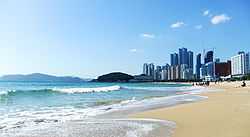Haeundae District
| Haeundae District 해운대구 | ||
|---|---|---|
| Autonomous District | ||
| Korean transcription(s) | ||
| • Hanja | 海雲臺區 | |
| • Revised Romanization | Haeundae-gu | |
| • McCune-Reischauer | Haeundae-gu | |
|
Haeundae Beach | ||
| ||
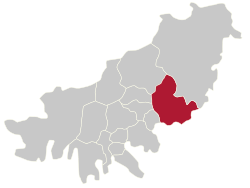 | ||
| Country | South Korea | |
| Region | Yeongnam | |
| Provincial level | Busan | |
| Administrative divisions | 18 administrative dong | |
| Area | ||
| • Total | 51.44 km2 (19.86 sq mi) | |
| Population (2007[1]) | ||
| • Total | 423,167 | |
| • Density | 8,226/km2 (21,310/sq mi) | |
| • Dialect | Gyeongsang | |
| Website | Haeundae District Office | |
Haeundae District is a gu in eastern Busan, South Korea. It has an area of 51.44 km², and a population of about 423,000. This represents about 11.6% of the population in Busan.[2] It became a division of Busan in 1976 and attained the status of gu in 1980.
Haeundae is an affluent beach front community that attracts tens of thousands of tourists during summer. It has been subject to considerable commercial development in recent decades.
The beach is linked to Busan Subway Line 2 and train stations on the Donghae Nambu railway line.
History
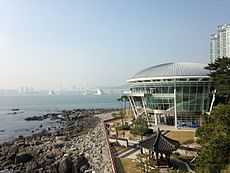
Haeundae takes its name from the ninth century Silla scholar and poet Choi Chi-won (literary name Haeun, or "Sea and Clouds"), who, according to a historical account, admired the view from the beach and built a pavilion nearby. A piece of Choi's calligraphy, which he engraved on a rock at Haeundae, still exists.[3]
Haeundae used to be isolated from the large communities in Busan and Busanjin. It remained undeveloped until the late 1970s and early 1980s. A small number of luxury hotels were constructed after the 1988 Seoul Olympics. More hotels and other tourist facilities have been constructed on the beach-front area since the mid-1990s, and shopping malls and movie theatre complexes have been built in the 'centre' of Haeundae: an area between Haeundae Station and the beach. The area has continued to grow, apart from during the Asian financial crisis of 1997.
Haeundae has been a regular host of the annual Busan International Film Festival (BIFF). Haeundae's Dongbaek Island was the location for the 2005 APEC Conference.
Haeundae New Town (해운대 신시가지-Haeundae Sinsigaji), a major commercial and residential redevelopment project begun in 1990, is located in the Jwa-dong area. This area lies in the southern shadow of Jangsan mountain to the north, and is bounded in the south by Haeundae Station on the Dalmaji Gogae line of the Korean National Railroad. Another development project, Centum City, has been ongoing since early 2000 and is now a major feature of Busan. Its BEXCO (Busan Exhibition and Convention Center) has become a popular venue for international conventions and exhibitions. Marine City, located nearby, is constructed on land reclaimed from the sea, and has several huge, high-rise apartment blocks. Additional apartment blocks are under construction, with water resorts and related facilities, for use by the public, also planned for Marine City.
Haeundae Dalmaji Hill
Haeundae’s Dalmaji Hill is touted as Korea’s best area to greet the moon. Busan’s citizens and tourists visiting the place bask in moonlight-drenched scenery while praying for their wishes to come true. Also, Haeundae’s Dalmaji (greet the Moon) Hill is touted as one of the eight attractions of Busan. Dynamic Busan introduces you to the best locale in the city where you can catch a view of the moon as Korea’s traditional Lunar New Year’s Day and Full Moon Day (Daeboreum) holidays are just around the corner. Dalmaji Hill in Haeundae boasts spectacular scenery. It is one of Korea’s most scenic areas and has been loved by our ancestors for generations. For example, Choe Chi-won (857-10th century), an official and poet from the late Unified Silla Dynasty (668-935), was so struck by its beauty that he decided to extend his stay there. The hill’s winding trail that juxtaposes with the ocean is truly awe-inspiring. Some even say that Dalmaji Hill is Busan’s answer to Montmartre. The hill, lined with old cherry blossom trees and flanked by the alluring ocean, boasts an enduring beauty regardless of the season.
Haeundae Beach
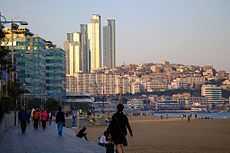
Haeundae Beach in Haeundae-gu is located at the southeast end of the city of Busan. Haeundae beach is 40 minutes away from Busan's main railroad station (in the Downtown area), and less than one hour from Gimhae International Airport. Along the 12 km of coastline is Busan's most popular beach, and with Seogwipo's, it is one of the most famous beaches in South Korea. Because of its easy access from downtown Busan, the beach is busy year round with several kinds of beach festivals. Most visitors are domestic. Dongbaekseom (Dongbaek Island), at the south end of the beach, is a popular fishing area. Oryukdo (Oryuk Islets), a symbol of Busan to many Koreans, can be seen in the distance from Dongbaek Island. During the hot summer months (late July to early August when most Koreans take their summer vacation), Haeundae beach becomes heavily crowded into a virtual human wall with thousands of people and parasols packed into a mile of sand. Visitors to the beach come from all over South Korea as well as outside of Korea. Haeundae is home to most of Busan's expatriate population.
There are many beach-related cultural events in Haeundae. Along with Geumjeongsan and Dalmaji (Greeting of the Moon) Gogae, Haeundae is one of the most popular spots in Busan to view the New Year sunrise, with around 1000 people gathering before dawn. Also, a popular beach event occurs in the first week of January when the temperature is around 0°C, the "Polar Bear Club." This event has occurred annually at the Choseon Beach Hotel since 1988. During the 2006 FIFA World Cup match between South Korea and Togo more than 50,000 spectators filled the beach to cheer for the Korean team on a giant projector screen.[4] The Nurimaru, pure Korean meaning for Nuri (World) and Maru (Peak or top) was developed in preparation for the 17th APEC(Asia pacific Economic Cooperation) summit on Nov 18-19 in 2005, as the conference hall for APEC. The building is three stories high and is located at the tip of Dongbaek Island. The ceiling of the Nurimaru is modeled after Seokguram, a Buddhist temple in Gyeongju.
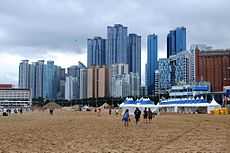
Film and Television
The district was the setting of the movie Haeundae, a South Korean disaster movie based on the somewhat unlikely scenario of an immense tsunami hitting the city of Busan.
The beach and Dongbaekseom Island was used as a filming location for Seoul Broadcasting System's 2008 drama Star's Lover. The island was the location for the scene where Lee Ma-ri, played by Choi Ji-woo confesses her love for Kim Chul Soo, played by Yoo Ji-tae; and the couple takes a walk on the beach.[5]
In 2012, KBS2 broadcast a drama, Haeundae Lovers, using Busan and the district as a backdrop. Much of the story takes place in Cheongsapo, a coastal community in the district east of Haeundae Beach.
Administrative divisions
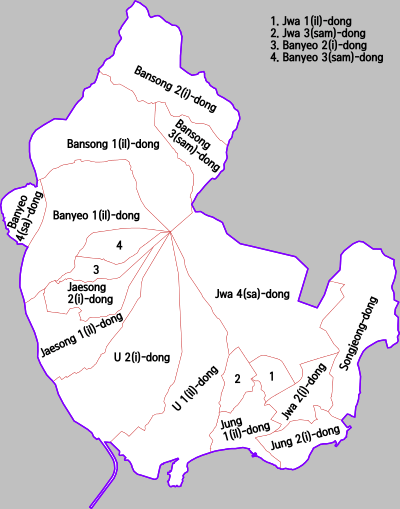

Haeundae-gu is divided into 7 legal dong, which altogether comprise 18 administrative dong, as follows:
- U-dong (2 administrative dong)
- Jung-dong (2 administrative dong)
- Jwa-dong (4 administrative dong)
- Songjeong-dong
- Banyeo-dong (4 administrative dong)
- Bansong-dong (3 administrative dong)
- Jaesong-dong (2 administrative dong)
See also
- Busan
- Busan International Film Festival
- Centum City
- List of Korea-related topics
- Geography of South Korea
References
- ↑ 국제비지니스관광의 중심 "해운대"로 오세요!
- ↑ 매력있는 세계일류도시 "해운대"로 오세요!
- ↑ Haeundae-gu Office
- ↑ http://www.korea.net/news/news/newsView.asp?serial_no=20060612010
- ↑ "A Star's Lover". Korean TV Drama. Korea Tourism Organization. Retrieved 30 May 2012.
External links
- Haeundae-gu website (in English)
| Wikivoyage has a travel guide for Haeundae. |
| Wikimedia Commons has media related to Haeundae-gu, Busan. |
| ||||||||||
Coordinates: 35°09′43″N 129°09′50″E / 35.16194°N 129.16389°E
